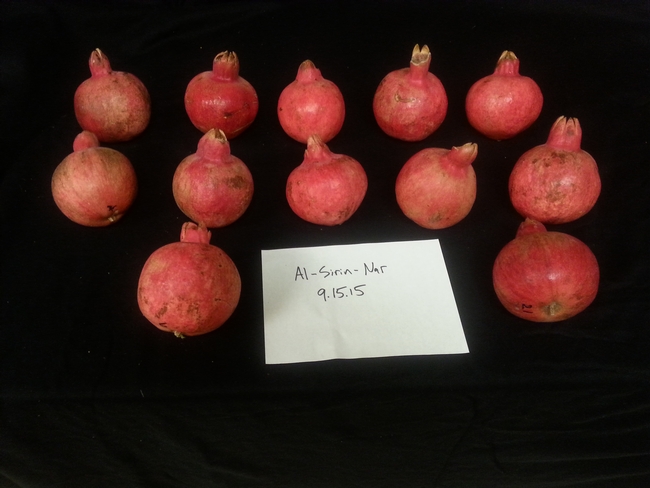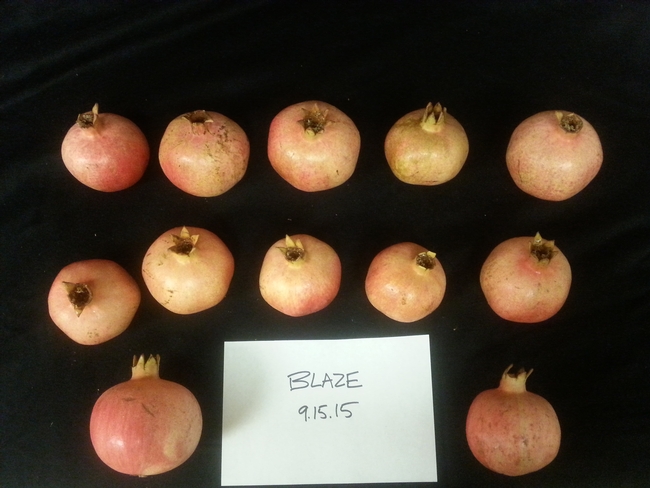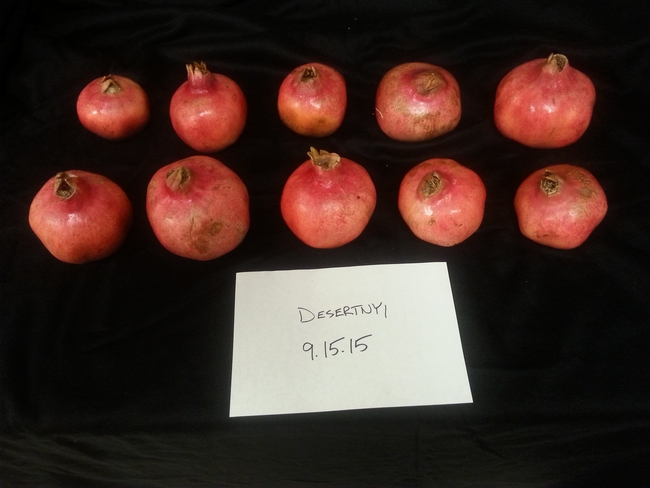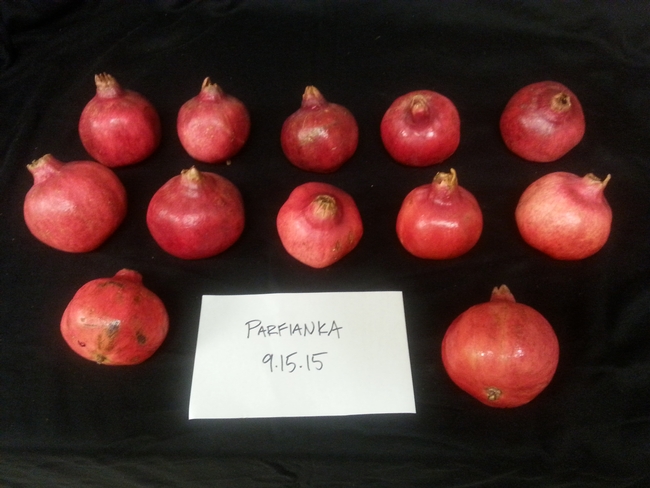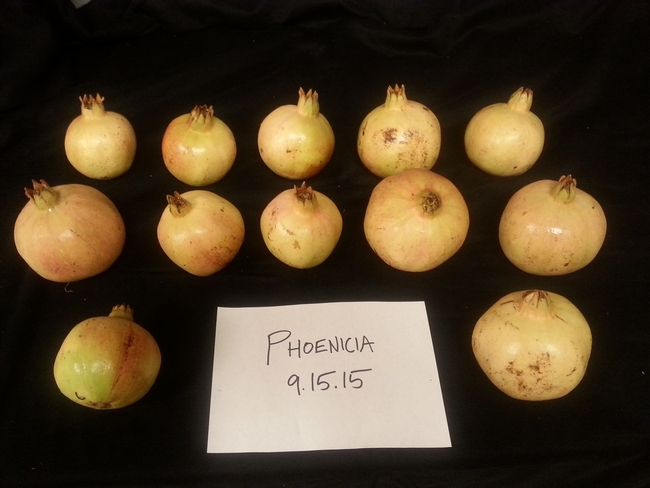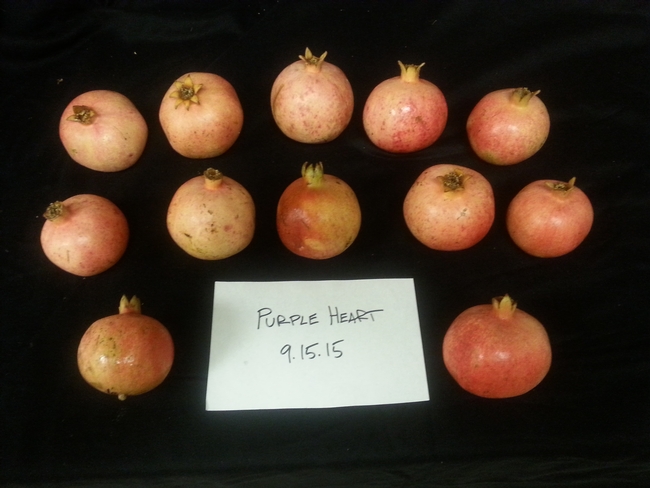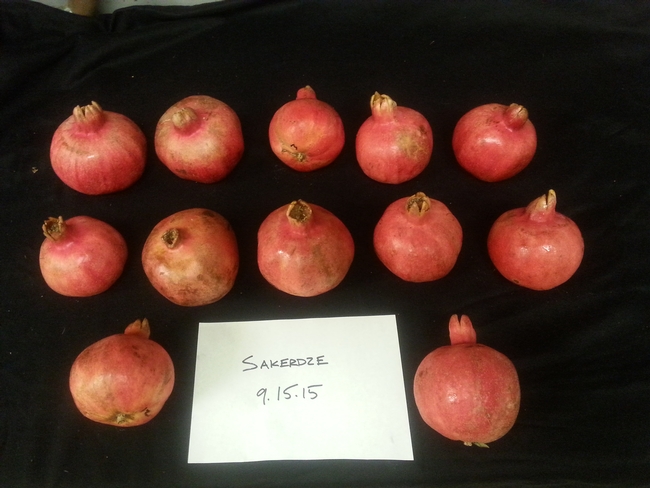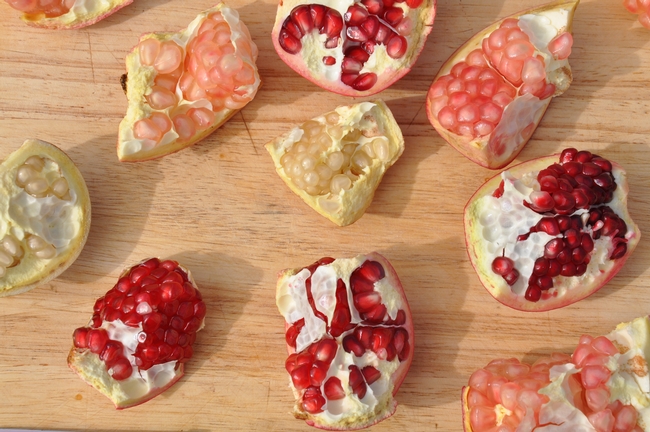
Posts Tagged: pomegranate
Time to 'Bee' Thankful
It's Thanksgiving Day, and as we sit down with family and friends to count our blessings,...
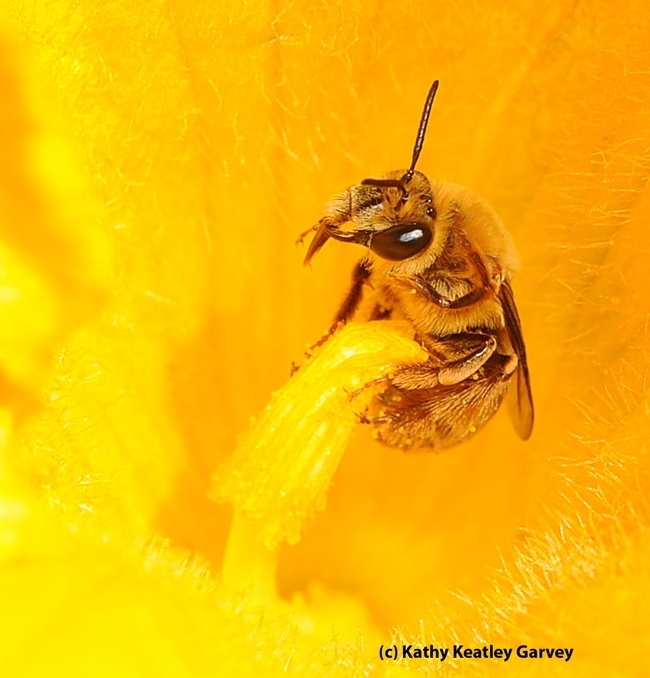
A squash bee, Peponapis pruinosa, pollinating a squash blossom. (Photo by Kathy Keatley Garvey)
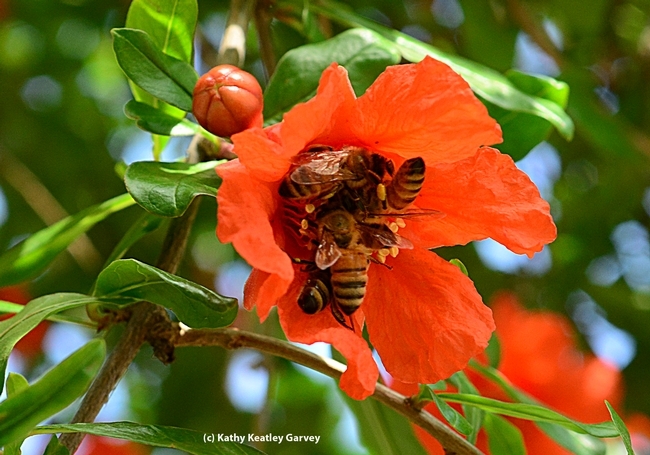
Five honey bees offering their pollination services on a pomegranate blossom. (Photo by Kathy Keatley Garvey)
May the Fourth Be With You
"The Redcoats are coming! The Redcoats are coming!" So shouted American Revolutionary patriot Paul...
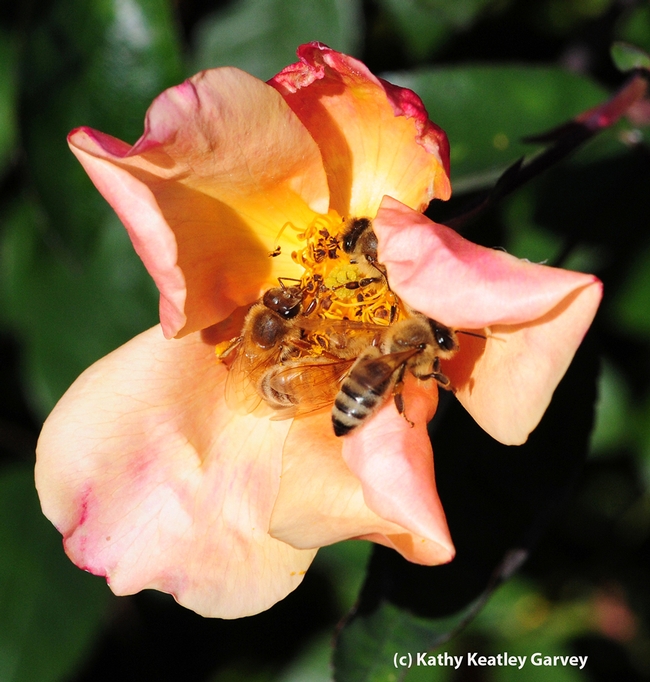
May the Fourth Be With You: Four honey bees share a rose blossom. (Photo by Kathy Keatley Garvey)
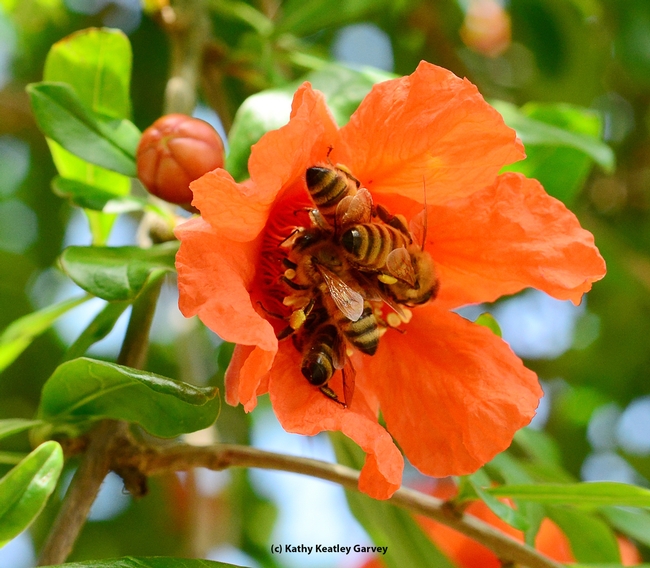
May the Fourth Be With You: Four honey bees share a pomegranate blossom. (Photo by Kathy Keatley Garvey)
Rainbow of potential alternative pomegranate varieties
Almost all pomegranates grown in the United States are one variety: Wonderful. John Chater, a Ph.D. student at the University of California, Riverside, wants to change that.
He would like to broaden the varieties of pomegranates available so that someone going to a supermarket can, like apples, buy varieties of pomegranates that vary in sweetness, seed hardness, flavor profile and color.
With that in mind, he has spent the last four years researching the commercial potential of 13 pomegranate varieties, and also started breeding new types of pomegranates.
He has field trials set up in Riverside and Somis, just east of Ventura, so he can evaluate the difference between coastal and inland climates. He has also chemically analyzed the juice of the varieties for quality.
Preliminarily, Chater, who is a 2016 University of California Global Food Initiative student fellow, has identified seven pomegranate varieties that have commercial juice potential. Three of them – Blaze, Phoenicia, and Purple Heart – were developed by his grandfather, who was a mechanic at a hospital but developed a cult following among fruit growers in California for developing new varieties of pomegranates.
Here are some of the pluses and minuses of each variety compared to Wonderful:
Al Sirin Nar: Large fruit, with hard seeds, soft peel, and large arils. With its sweet-tart juice, it could be useful for juice applications. Seeds may be too hard to be sold as a whole fruit.
Blaze: Medium sized fruit, juice more sweet than tart. Fruit similar to Wonderful. Could serve coastal and inland growers. Has potential to be sold as a whole fruit.
Desertnyi: Soft-seeded, medium sized fruit with ornamental quality. Delicious balanced flavor that has been described as citrus-like. Trees seem to may need trellis or rootstocks for commercial production. Has potential to be sold as a whole fruit.
Parfianka: Soft seeded variety with sweet-tart to sweet flavor. Very precocious in the field and on both inland and on the coast. This variety is an international favorite for its refreshing flavor and soft seeds. Has potential to be sold as a whole fruit.
Phoenicia: Large fruit with medium to hard seeds. Fruit multicolored with yellow, pink, and reds. Sweet-tart flavor with a tartness that consumers enjoy. Fruit seems to keep well in storage.
Purple Heart: Medium-sized red fruit that has dark red juice and arils. Fruit and juice similar to ‘Wonderful'. Sold as ‘Sharp Velvet' at Dave Wilson Nursery.
Sakerdze: Large fruit, with hard seeds, soft peel, and large arils. Juice is sweet to sweet tart. Fruit can be pinkish to red.
Expanding pomegranate production
John Chater remembers the day vividly. He was about two years old. His grandfather gave him a dark, purplish pomegranate. Happily, he opened it and starting eating.
He quickly realized his mistake. He was wearing his new light brown suede shoes. The pomegranate juice quickly found the shoes, leaving a permanent scar.
“That was my first experience, that I remember, with pomegranates, and it involved getting in trouble,” Chater said. “Because it was so delicious, I didn't realize it would stain.”
More than 30 years later, Chater is a Ph.D. student at the University of California, Riverside, with a focus on pomegranate research and a 2016 University of California Global Food Initiative student fellow. He is building on the work of his grandfather, S. John Chater, who was a maintenance worker at hospital but developed a cult following among rare fruit growers in California for developing new varieties of pomegranates.
The younger Chater, working with varieties selected from the National Clonal Germplasm Repository in Winters, including several developed by his grandfather (who died in 2002), is working to better understand the commercial potential of these varieties.
Currently, 90 to 95 percent of pomegranates are one variety: Wonderful, Chater said. (In addition, California grows more than 95 percent of pomegranates in the United States, he said.)
Working under Don Merhaut, UC Cooperative Extension specialist for ornamental and floriculture crops at UC Riverside, Chater has set up pomegranate variety trials in Riverside and Camarillo.
They have planted 12 pomegranate varieties, 15 trees per variety, to evaluate their establishment, precocity (flowering and fruiting), usefulness to growers and desirability to consumers.
Of the 12 varieties, 10 are edible (Parfianka, Desertnyi, Wonderful, Ambrosia, Eversweet, Haku Botan, Green Globe, Golden Globe, Phoenicia and Lofani) and two are ornamental (Ki Zakuro and Nochi Shibori). The ornamental varieties, whose flowers look like carnations, could be of interest to the floriculture industry, Chater said.
The researchers want consumers to be able to go to supermarket, and, like apples and citrus, be able to buy different varieties of pomegranates that vary in sweetness, seed hardness and color. (The varieties Chater is studying range in color from green to yellow to pink to orange to red to nearly purple.)
Chater set up the trials in Riverside and Camarillo to evaluate the difference between the cooler coastal climate and the warmer inland climate.
The prevailing thought is that more acidic varieties do better in inland conditions because the high summer temperatures reduce the acidity before the fruit is picked in the fall.
For example, a variety such as Wonderful, which is high in acidity, is grown commercially in the Central Valley. But, Eversweet, which has a lower acidity, does well on the coast.
Related to color, some researchers believe that pomegranates color up because of cool night time temperatures. Therefore, trees planted on the coast tend to color up faster.
All that said, it is believed no one has done a comprehensive study, such as the experimentally-designed one Chater has set up, in the United States. It will allow him to study the interplay of variables including size, color, sweetness, acidity, antioxidant activities and seed hardness in different climate conditions.
This story en español.
View a video featuring John Chater and his pomegranate research below:
The Taste of Honey--Pomegranate Honey
Last spring you may have seen honey bees pollinating the showy pomegranate blossoms. The ancient...
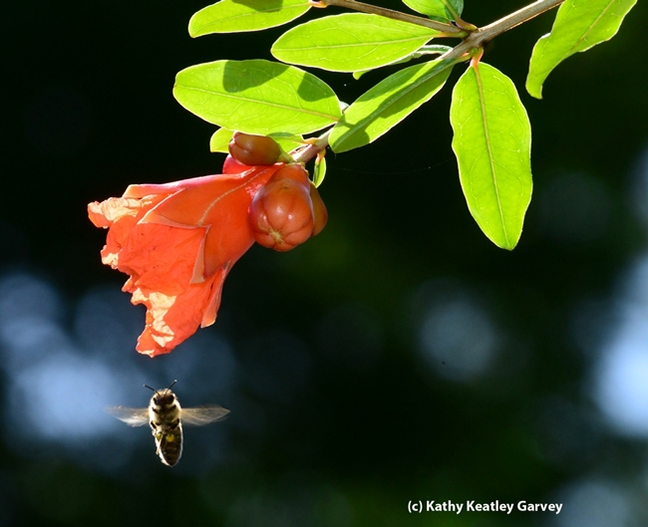
A honey bee heads toward a pomegranate blossom. (Photo by Kathy Keatley Garvey)
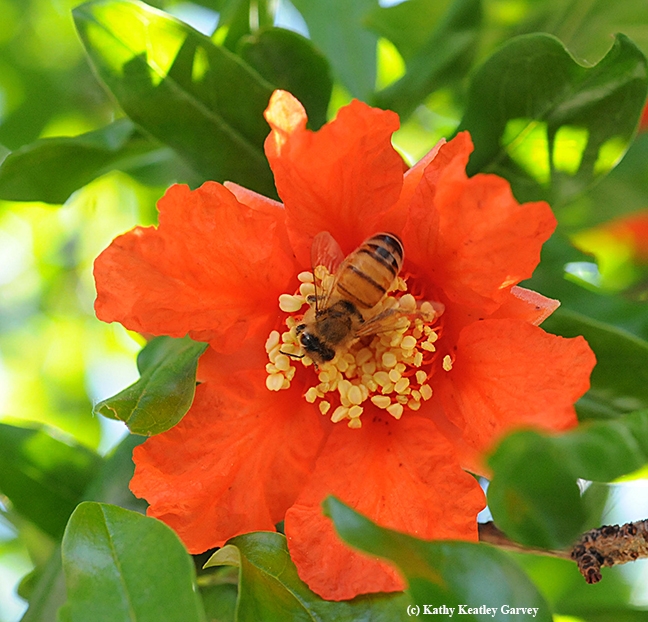
A honey bee pollinating a pomegranate blossom. (Photo by Kathy Keatley Garvey)
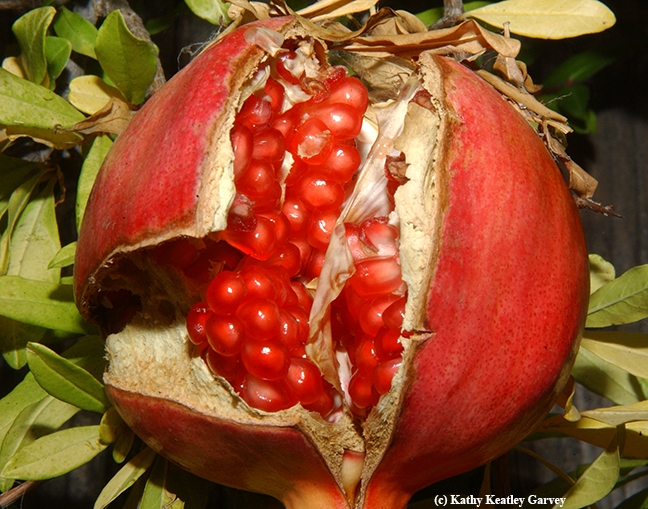
This is what the bees did! A mature pomegranate full of ruby red seeds. (Photo by Kathy Keatley Garvey)

